[ad_1]
About a third of the way through Mineko’s Night Market, a young boy dressed as a fish says to his octopus-chopping father, “What? I just thought sending the local errand kid on missions was how people acquired stuff on this island.” To many, this will simply be a comic jibe at what you, the aforementioned local errand kid, have been doing for the last eight hours or so. After moving to this rural backwater with your dad in search of a better life, you quickly realise that no one in this town ever gets off their arse to get anything done.
Instead, it’s up to you, Mineko, to fulfil every last one of their desires, whether it’s collecting 50 bits of wood so they can construct a frame for their new house (before asking you for 50 bits of paper to give it some flimsy-looking walls), buying and delivering them a sports drink they could have easily got themselves from the local shop, or crafting a flower box for them because, well, they asked you to. As I said, industry isn’t exactly their strong suit here, and you’d be forgiven for wondering how any of them functioned as human beings before you arrived.
But this line of dialogue also strikes right at the heart of what a joyless experience Mineko’s Night Market is. It reveals the cold, lifeless husk beneath its lovely visuals. It’s nothing but ‘Me, me, me’ and ‘Take, take, take’ in this game, and NPCs offer nothing in return except soul-crushing tedium and a long list of repetitive chores. Animal Crossing this is not, my friends, so don’t be fooled. This is about as far from ‘cosy’ and ‘cute’ as you can possibly get – and that’s despite it having dozens of pet-able cats.
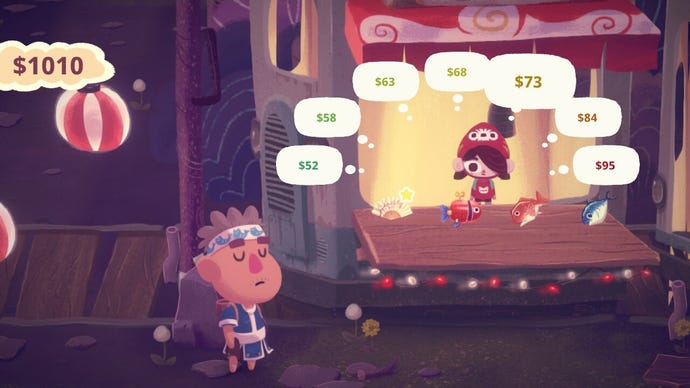
At first, Mineko’s Night Market’s underlying rhythm of ‘collect resources to get money to buy more tools to open up different parts of the island to collect more resources etc.’ feels well-judged. There are enough new things on your to-do list to make your daily bus trips to one of its single resource locations feel fresh and exciting. The gap between what you’re earning from selling off your accumulated wares and what you need to shell out for the next new shiny thing to open up more of the map is just enough for it feel aspirational, but achievable. Nothing a couple of in-game days’ worth of fishing, tree-chopping, flower-picking, or rock mining won’t sort out, and by the time the weekly night market comes around on Saturday evening, where you can sell off your more bespoke, hand-crafted goods for mega money, you’ll be positively rolling in it.
There are other diversions to slowly tick off in Mineko’s Night Market as well. Like Animal Crossing, there are museums in town where you can donate samples of your flower, fish, rock and food collecting for all to admire – or at least that’s what they tell you. I never actually saw anyone come to look at these unimaginative lines of pedestals, even after collecting enough samples for the respective museum owner to deem their building officially ‘open’ to the public. The only discernible difference between them being open and closed is that the fronting is mildly more attractive, and no longer has any offending cobwebs on show.
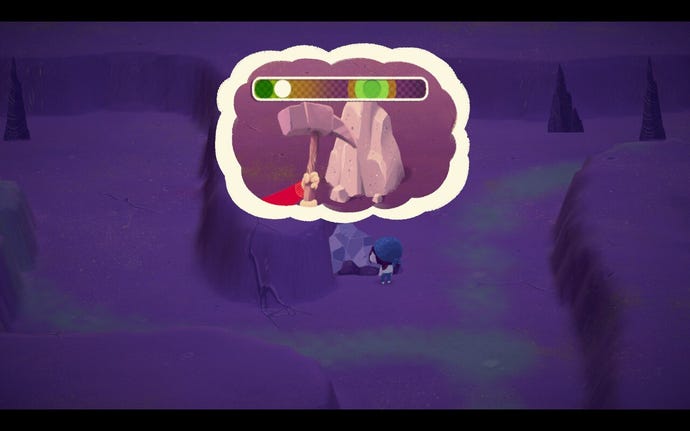

And of course, let’s not forget that long list of villager requests to keep you busy. While some of these items can simply be bought straight off the bat, most require you to make stuff from specific crafting blueprints. Each villager has five such requests to their name, which the game dresses up as friendship levels – although good luck remembering who wants what, as nowhere in your menu-like notebook does it ever record it, resulting in tedious chats with every sucker in town to figure out which idiot wanted the mailbox and which one wanted the boy band body pillow. These friendships amount to nothing more than chucking items into their void-like mouths, in the vain hope they’ll spit out another relevant crafting blueprint as a reward, which you can then use to make another piece of handmade tat to feed to someone else.
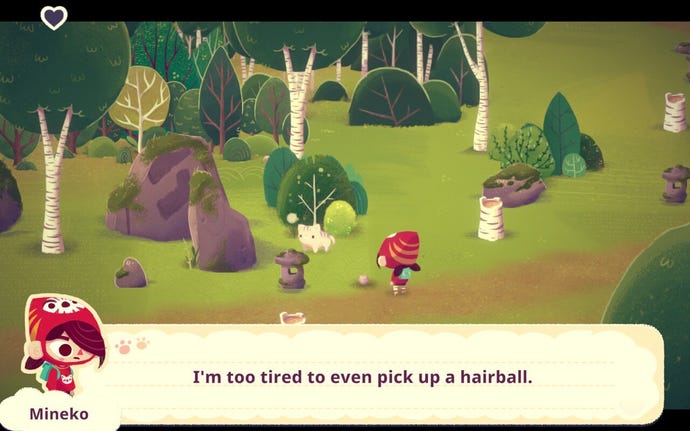
Food and drink are actually quite useful early on when you only have a single heart’s worth of energy to do your daily resource gathering with, as you’ll only get a handful of actions in before you’re literally “too tired to pick a flower”, forcing you to head home and call it a day. But by the time you’ve got to this point and collected all of its blueprint rewards, you’ve got all the hearts and energy you really need to do a decent day’s work, making their presence feel slightly redundant.Image credit: Rock Paper Shotgun/Humble Games
To what end, you might ask? A motivational cul-de-sac, that’s what. Aside from some marginally friendlier lines of dialogue when you engage them in conversation – and even then that’s not guaranteed – these chumps never make you anything in return, and it all starts to feel extremely one-sided. Even worse, when you eventually collect every last blueprint in the game, the only rewards you get after that are mildly pointless food items. I kid you not, when I finally gave one kid the two Black Ramen pots he’d wanted for ten hours (I couldn’t buy Black Ramen early on, either at the shop or at the night market itself), what did he give me in return? Two more Black Ramen. As did the three other brats after him. Where was this underground Black Ramen market when I needed it, goddamnit?
As my incentive to please my neighbours fell away, my sole motivation became to make as much cash as possible, because that’s really your only purpose in this game. You can’t decorate your own home, or plop down ponds or the flower wreaths you make around town. Sure, your dad sometimes has the odd quest for you to spruce up your home, but it’s all prescribed demands for 50 wood, and offers no form of creative expression like other life sim-type games. But even my mercantile aspirations started to waver when Mineko’s second act began, as the sheer cost involved in moving the story forward suddenly changed from that aspirational hill to a gaping chasm of tedious despair. Prices for story-critical tools sky-rocketed, and what previously took a couple of days work now took over a week, often two. Even the money-spinning night market wasn’t enough to give my wallet a bump anymore.
Part of this frustration comes from trying to get through Mineko at a reasonable rate (that, and the fact that, on Steam Deck at least, loading times were unbearably slow). But even if it’s played at a more leisurely pace, the mind-numbing tedium of its basic resource gathering can’t help but make Mineko feel like a chore. Every time you want to fish, chop or mine a bit of rock, you’re subjected to tiresome, repetitive and almost insultingly simple mini-games, and the grind to earn enough cash to unlock the next monotonous collectathon just turns into dismal drudge work.
There’s a reason why Animal Crossing operates in real-time, and I suspect it’s because this is what it would become otherwise – a soul-sucking dirge of holding A to swing a wood/pick axe, and tapping the same button on its interminably slow pond and sea shadows to reel in the same handful of aquatic life all year round. Add to all this some truly terrible stealth sequences where you’re dodging FBI-like agents who, for reasons, have caged the island’s cat population inside easily thwarted patrol patterns, and you can’t even get excited about the prospect of visiting somewhere new because you know you’ll have to clear out these idiots first.
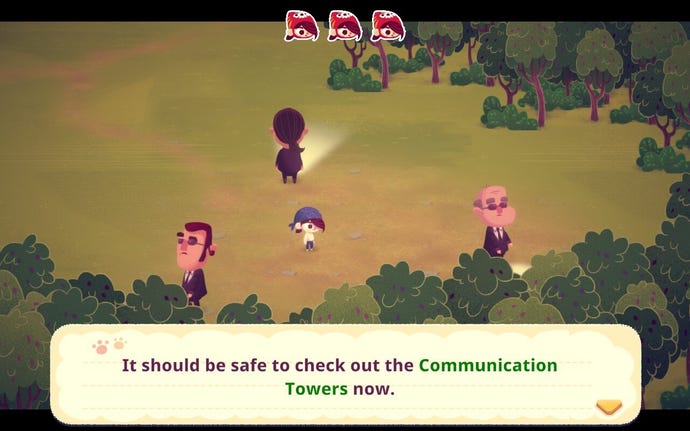
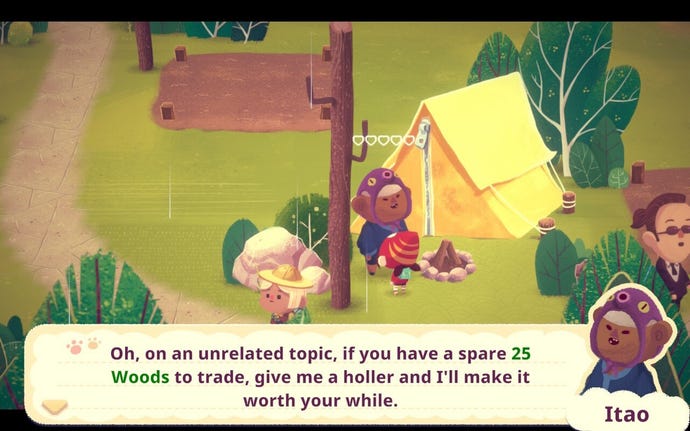
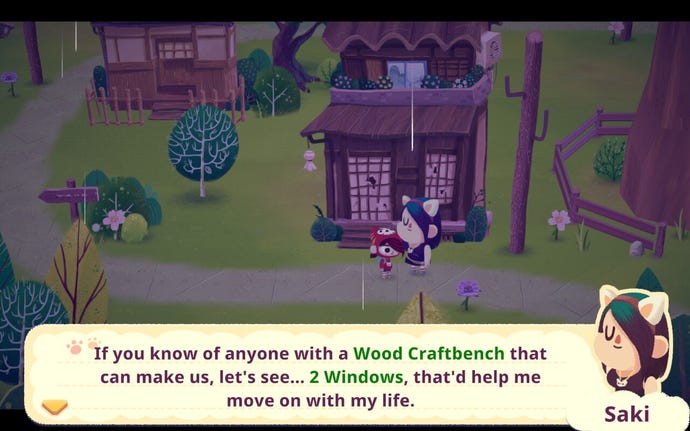
To add insult to injury, when you finally push through to the last crop of tools and craft benches, the need to make money then completely evaporates. Rather, your objectives switch to hoarding your resources so you can feed them into yet more (now story-critical) mouth bins. Engaging with the game’s titular night market is subsequently reduced to just another burdensome task you’ve got to endure in your weekly timetable, and you end up actively wanting to avoid the whole thing, so you can keep the stuff you need for the story rather than waste it on crafting items to earn money you no longer need. In short, Mineko’s Night Market never coheres into an enjoyable whole. There’s always at least one part that grates against another – and frequently it’s not just one thing, but everything rubbing you up the wrong way and pulling you in different directions. Being the local errand kid is a pretty thankless task at the end of the day, and the more time you try and invest in this game, the poorer you feel at the end of it.
This review is based on a review build of the game provided by publishers Humble Games.
fbq('track', 'PageView'); window.facebookPixelsDone = true;
window.dispatchEvent(new Event('BrockmanFacebookPixelsEnabled')); }
window.addEventListener('BrockmanTargetingCookiesAllowed', appendFacebookPixels);
[ad_2]
